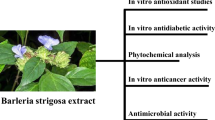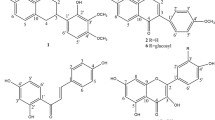Abstract
In this study, a novel peptide was isolated from the black soybean byproduct using bioactive guided isolation technique. Initially, the hydrolysate of black soybean protein was fractionated and separated sequentially by ultrafiltration, Sephadex G 25 chromatography and reverse-phase HPLC techniques. The peptide fractions that collected in each step were tested for their antioxidant capacity and anticancer activities against human liver (HepG2), lung (MCF-7) and cervical (Hela) cancer cell lines. The most active fraction was subjected to further purification. The final purified peptide fraction (F2-c) with the molecular weight of 455.0 Da showed highest DPPH free radical scavenging and hydroxyl radical scavenging activity with the IC50 values of 0.12 and 0.037 µM, respectively. Moreover, it showed high cytotoxic potential against HepG2, MCF-7 and Hela cells with the IC50 values of 0.22, 0.15 and 0.32 µM, respectively. The amino acid sequence of F2-c was identified as Leu/Ile-Val-Pro-Lys (L/I-VPK). Molecular docking studies revealed that the purified peptides effectively bound with four apoptosis related key proteins (XIAP, caspase-3, caspase-7, and Bcl-2) via hydrophobic effects and hydrogen bonds, amongst them, the peptide-caspase-3 binding showed the strongest binding energy. All the results suggested that the peptide fraction Leu/Ile-Val-Pro-Lys from black soybean byproduct with significant antioxidant and anticancer activities could be a good candidate for functional foods or related drugs.
Graphical abstract





Similar content being viewed by others
References
Lobo V, Patil A, Phatak A, Chandra N (2010) Free radicals, antioxidants and functional foods: Impact on human health. Pharmacogn Rev 4:118–126
Valko M, Leibfritz D, Moncol J, Cronin MTD, Mazur M, Telser J (2007) Free radicals and antioxidants in normal physiological functions and human disease. Int J Biochem Cell B 39:44–84
Harnedy PA, O’Keeffe MB, Fitzgerald RJ (2017) Fractionation and identification of antioxidant peptides from an enzymatically hydrolysed Palmaria palmata protein isolate. Food Res Int 100:416–422
Torre LA, Bray F, Siegel RL, Ferlay J, Lortet-Tieulent J, Jemel A (2015) Global cancer statistics CA. Cancer J Clin 65:87–108
Lei Y, Zhang D, Yu J, Dong H, Zhang J, Yang S (2017) Targeting autophagy in cancer stem cells as an anticancer therapy. Cancer Lett 393:33–39
Vendrely V, Peuchant E, Buscail E, Moranvillier I, Rousseau B, Bede A, Brillac A, de Verneuil H, Moreau-Gaudry F, Dabernat S (2017) Resveratrol and capsaicin used together as food complements reduce tumor growth and rescue full efficiency of low dose gemcitabine in a pancreatic cancer model. Cancer Lett 390:91–102
Zhou C, Hu J, Ma H, Yagoub AE, Yu X, Owusu J, Ma H, Qin X (2015) Antioxidant peptides from corn gluten meal: orthogonal design evaluation. Food Chem 187:270–278
Wang X, Chen H, Fu X, Li S, Wei J (2017) A novel antioxidant and ACE inhibitory peptide from rice bran protein: biochemical characterization and molecular docking study. LWT Food Sci Technol 75:93–99
Nurdiani R, Vasiljevic T, Yeager T, Singh TK, Donko ON (2016) Bioactive peptides with radical scavenging and cancer cell cytotoxic activities derived from flathead (Platycephalus fuscus) by-products. Eur Food Res Technol 243:627–637
Xu B, Chang SKC (2008) Antioxidant capacity of seed coat, dehulled bean, and whole black soybeans in relation to their distributions of total phenolics, phenolic acids, anthocyanins, and isoflavones. J Agric Food Chem 56:8365–8373
Odani S, Koide T, Ono T (1987) Amino acid sequence of a soybean (Glycine max) seed polypeptide having a poly (l-aspartic acid) structure. J Biol Chem 262:10502–10505
Galvez AF, de Lumen BO (1999) A soybean cDNA encoding a chromatin-binding peptide inhibits mitosis of mammalian cells. Nat Biotechnol 17:495–500
Fernández-Tomé S, Sanchón J, Recio I, Hernández-Ledesma B (2017) Transepithelial transport of lunasin and derived peptides: inhibitory effects on the gastrointestinal cancer cells viability. J Food Compos Anal 68:101–110
Hsieh CC, Martínezvillaluenga C, de Lumen BO, Hernándezledesma B (2017) Updating the research on the chemopreventive and therapeutic role of peptide lunasin. J Sci Food Agric 98:2070–2079
Rayaprolu SJ, Hettiarachchy NS, Chen P, Kannan A, Mauromostakos A (2013) Peptides derived from high oleic acid soybean meals inhibit colon, liver and lung cancer cell growth. Food Res Int 50:282–288
Norat T, Lukanova A, Ferrari P, Riboli E (2001) Meat consumption and colorectal cancer risk: dose–response meta-analysis of epidemiological studies. Int J Cancer 98:241–256
González-Montoya M, Hernández-Ledesma B, Silván JM, Mora-Escobedo R, Martínez-Villaluenga C (2017) Peptides derived from in vitro, gastrointestinal digestion of germinated soybean proteins inhibit human colon cancer cells proliferation and inflammation. Food Chem 242:75–82
Chen Z, Wang J, Liu W, Chen H (2017) Physicochemical characterization, antioxidant and anticancer activities of proteins from four legume species. J Food Sci Technol 54:964–972
Walsh JG, Cullen SP, Sheridan C, Lüthi AU, Gerner C, Martin SJ (2008) Executioner caspase-3 and caspase-7 are functionally distinct proteases. Proc Natl Acad Sci USA 105:12815–12819
Hossbach J, Michalsky E, Henklein P, Jaeger M, Daniel PT, Preissner R (2009) Inhibiting the inhibitors: retro-inverso smac peptides. Peptides 30:2374–2379
Adams JM, Cory S (1998) The Bcl-2 protein family: arbiters of cell survival. Sci 281:1322–1326
Némati F, Montrion CD, Lang G, Krausberthier L, Carita G, Sastregarau X (2014) Targeting Bcl-2/Bcl-xl induces antitumor activity in uveal melanoma patient-derived xenografts. Plos One 9:e80836
Ashkenazi A, Fairbrother WJ, Leverson JD, Souers AJ (2017) From basic apoptosis discoveries to advanced selective Bcl-2 family inhibitors. Nat Rev Drug Discov 16:273–284
Wakui N, Yoshino R, Yasuo N, Ohue M, Sekijima M (2017) Exploring the selectivity of inhibitor complexes with Bcl-2 and Bcl-xl: a molecular dynamics simulation approach. J Mol Graph Model 79:166–174
Zhang Y, Chen H, Zhang N, Ma L (2015) Antioxidant and functional properties of tea protein as affected by the different tea processing methods. J Food Sci Technol 52:742–752
Zhou DY, Zhu BW, Qiao L, Wu HT, Li DM, Yang JF, Murata F (2012) In vitro, antioxidant activity of enzymatic hydrolysates prepared from abalone (Haliotis discus hannai, Ino) viscera. Food Bioprod Process 90:148–154
de Avellar IG, Magalhães MM, Silva AB, Souza LL, Leitão AC, Hermeslima M (2004) Reevaluating the role of 1,10-phenanthroline in oxidative reactions involving ferrous ions and DNA damage. Biochim Biophys Acta 1675:46–53
Trott O, Olson AJ (2009) Autodock vina: improving the speed and accuracy of docking with a new scoring function, efficient optimization, and multithreading. J Comput Chem 31:455–461
Hsu KC, Li-Chan ECY, Jao CL (2011) Antiproliferative activity of peptides prepared from enzymatic hydrolysates of tuna dark muscle on human breast cancer cell line MCF-7. Food Chem 126:617–622
Huang Y, Wang X, Wang H, Liu Y, Chen Y (2011) Studies on mechanism of action of anticancer peptides by modulation of hydrophobicity within a defined structural framework. Mol Cancer Ther 10:416–426
Kim SE, Kim HH, Kim JY, Kang YI, Woo HJ, Lee HJ (2000) Anticancer activity of hydrophobic peptides from soy proteins. Biofactors (Oxford England) 12:151–155
Song R, Wei RB, Luo HY, Yang ZS (2014) Isolation and identification of an antiproliferative peptide derived from heated products of peptic hydrolysates of half-fin anchovy (Setipinna taty). J Funct Foods 10:104–111
Xue Z, Wen H, Zhai L, Yu Y, Li Y, Yu W, Cheng A, Wang C, Kou X (2015) Antioxidant activity and anti-proliferative effect of a bioactive peptide from chickpea (Cicer arietinum L.). Food Res Int 77:75–81
Wang WY, De Mejia EG (2005) A new frontier in soy bioactive peptides that may prevent age-related chronic diseases. Compr Rev Food Sci Food Saf 4:63–78
Li JT, Zhang JL, He H, Ma ZL, Nie ZK, Wang ZZ, Xu XG (2013) Apoptosis in human hepatoma HepG2 cells induced by corn peptides and its anti-tumor efficacy in H22 tumor bearing mice. Food Chem Toxicol 51:297–305
Luna Vital DA, Loarca-Piña G, Dia VP, de Mejía EG (2014) Peptides extracted from common bean (Phaseolus vulgaris L.) non-digestible fraction caused differential gene expression of HCT116 and RKO human colorectal cancer cells. Food Res Int 62:193–204
Ortiz-Martinez M, de Mejia EG, García-Lara S, Aguilar O, Lopez-Castillo LM, Otero-Pappatheodorou JT (2017) Antiproliferative effect of peptide fractions isolated from a quality protein maize, a white hybrid maize, and their derived peptides on hepatocarcinoma human HepG2 cells. J Funct Foods 34:36–48
Zhang M, Tang X, Wang F, Zhang Q, Zhang Z (2013) Characterization of lycium barbarum polysaccharide and its effect on human hepatoma cells. Int J Biol Macromol 61:270–275
Acknowledgements
This work was supported by the Grant from National High Technology Research and Development Program (“863"Program) of China (Grant no. SS2013AA100207) and the National Natural Science Foundation of China (NSFC 31371879).
Author information
Authors and Affiliations
Corresponding author
Ethics declarations
Conflict of interest
There are no conflicts of interest to declare.
Compliance with ethics requirements
This article does not contain any studies with human or animal subjects.
Electronic supplementary material
Below is the link to the electronic supplementary material.
Rights and permissions
About this article
Cite this article
Chen, Z., Li, W., Santhanam, R.K. et al. Bioactive peptide with antioxidant and anticancer activities from black soybean [Glycine max (L.) Merr.] byproduct: isolation, identification and molecular docking study. Eur Food Res Technol 245, 677–689 (2019). https://doi.org/10.1007/s00217-018-3190-5
Received:
Revised:
Accepted:
Published:
Issue Date:
DOI: https://doi.org/10.1007/s00217-018-3190-5




